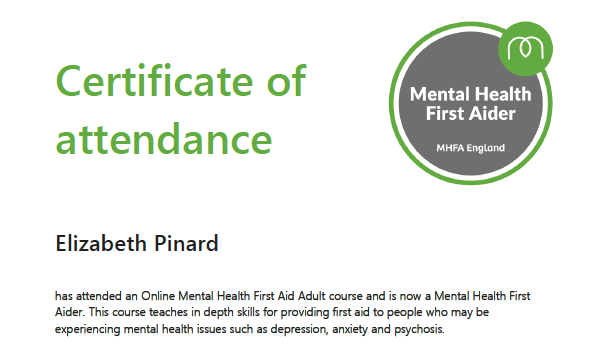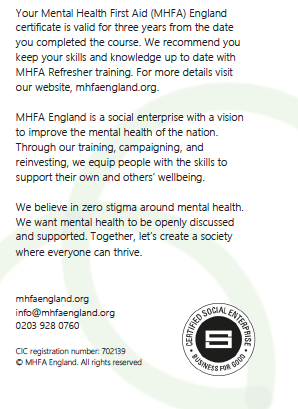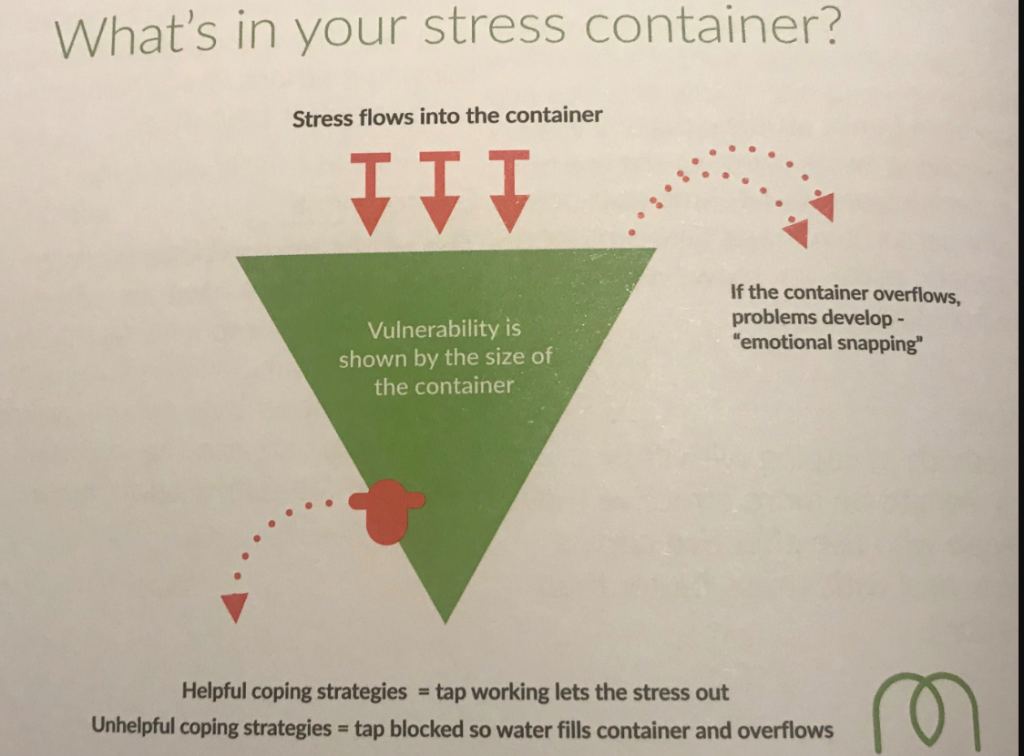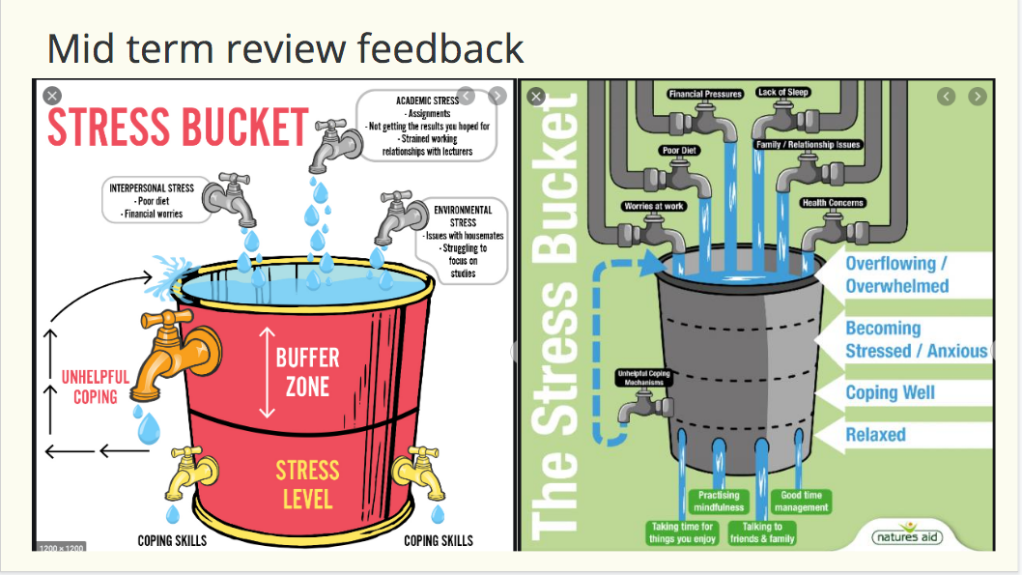I am now a qualified Mental Health First-aider! I completed a two day course run by MFHA England on 17th and 18th of February (been playing catch-up ever since because of losing those two days of work!!) in order to be a Mental Health First Aider for my team at work, along with a colleague of mine who did it the same week but a different two days.

This blurb is also on it:

The course took place entirely online and consisted of 4 live sessions and 4 independent learning modules, all of which were integrated in their online learning platform. The course took place entirely online and consisted of 2 days which included 4 live sessions and 4 independent learning modules, all of which were integrated in their online learning platform. We also received hard copy materials – a thick manual and a workbook – in advance of the course. Before the pandemic they did face to face classes but, like everyone else, they had to adapt to the pandemic.
In this post, I will share one key concept and a related concept that I found really helpful and that I think could be helpful for anybody and everybody to know about, and how I have already integrated it into my teaching.
Stress Container

This is the first time I’ve come across the idea of a stress container and having a stress container but a quick Google shows that it turns out to be in wide usage. It has been adapted for workplace training materials, for students etc. The size of your stress container is influenced by your frame of reference (another useful concept) which is your window on the world. It in turn is formed by, amongst others, age, gender, work, hobbies/interests, place of birth, early childhood experiences, socio-economic background, cultural influences, sexuality, education, aspirations, spirituality, likes/dislikes, any disability, any chronic illness, family situation/size, achievements, values and relationships. Currently, also experiences of the pandemic. Depending on your experience of any of the above, the size of your stress container may be bigger or smaller i.e. you can tolerate higher or lower levels of stress before the container is filled up. If it gets full, problems develop – chronic stress, exhaustion, anxiety, depression etc. Stressors can be many and varied and may be in there temporarily or long term. Importantly, they may be good (e.g. a wedding next year, a new job/a promotion, a new relationship), stressors aren’t necessarily bad but whether good or bad, take up space in your stress container levels.
However, we can open the tap and let some of the contents flow out from the bottom. This means using helpful coping strategies such as meditation, connecting with others, exercising, getting enough sleep, participating in hobbies/leisure pursuits – generally anything that helps you relax without further damage to your body/mind. Of course, people also use unhelpful coping strategies in order to cope with the stress of life, such as smoking, excessive alcohol consumption, overeating etc, which may numb the effect of the stressors but not relieve it. This is akin to the tap getting blocked so the contents of the stress container cannot be released, which again leads to problems developing as overflow/overwhelm happens.
So that is the general idea of it. It is a way to conceptualise/visualise stress levels and coping mechanisms. This in turns allows you to evaluate yours – is there more in it than you realised/thought before considering what is in it? – and recognise when it is filling up and take positive steps to relieve that (and feel justified in doing so – it is all too common to feel guilty for taking time for oneself in whatever format that takes!). It can help you make sense of why something that “doesn’t ordinarily bother you” or that you “normally find easy enough” is difficult on a certain occasion or occasions. If you are anticipating a number of incoming stressors, you can prepare by proactively using your preferred positive coping strategies and planning how you will continue to do so when the stressors enter your container. It also allows you to visualise how and why things different affect different people differently and to differing amounts. For example. a busy period at work may be experienced differently by someone who is also going through relationship difficulties or suffering with poor health or struggling with home-schooling children. Depending how full a stress-container is, a seemingly small thing can be the final straw for someone because there just isn’t space.
To me, none of the above is particularly new in and of itself but the stress container metaphor helps give it all coherence and, importantly, while the locus of control for some of it is outside our control (stress container size, stressors), it does show that we do have some control which it is important to exercise for our wellbeing, in terms of which coping strategies we use and when/how often we use them. I have already used the stress container/stress bucket metaphor with my students since learning about it. I did a mid-term feedback form and one of the questions asked them how they are feeling at the moment and stressed/under pressure/tired were common themes. Which is normal on an intense course like the one they are following with us (multiple modules, not only Academic English, and a heavy assessment load all round). In a subsequent lesson, as part of responding to the feedback I introduced the stress container/bucket, using images found online, reassuring them it was normal to feel stressed (it doesn’t mean they aren’t good enough to do the course or that they are a failure or anything like that – which is not a common assumption to make when you are in the midst of doing something that generates stress!) and that the important thing is to deal with it appropriately so that you don’t reach the point of overwhelm, and got them to share their favourite positive coping strategies in the chat box.

Having awareness is the first step towards having more control. If you are aware of what is happening, you can do something about it before you reach a crisis point. I plan to return to it periodically (another bonus of a coherent image is that it is easy to keep coming back to it because there is something tangible to come back to!) and continue with my Wellbeing column on our Class Noticeboard Padlet – where each week I share a resource/idea relating to promoting mental health and wellbeing (see examples below).



I don’t know how much of it they access but at the very least it, in combination with the feedback form question and feedback, sends the message that mental health and wellbeing is important, that mental health isn’t something that is only talked about when things go wrong and that things being difficult is nothing to be ashamed of. It also means that as time wears on (we are still in term one for this cohort!), and the stress load increases for these students (if not this year, then when they go on to university), they will know they aren’t alone with it, hopefully feel less ashamed than they might otherwise have to own it and be more willing to access the support that is available to them.
To finish off, here is an MFHA link from a 2018 campaign which focuses on stress and contains a little slide show about the stress container and some awareness raising activities. I hope it, and this post, will be of some use for you. I would recommend to anybody thinking about it to do a Mental Health first aid course both for personal gain and for better ability to help others.

Pingback: Useful links on Mental Health in ELT | Sandy Millin